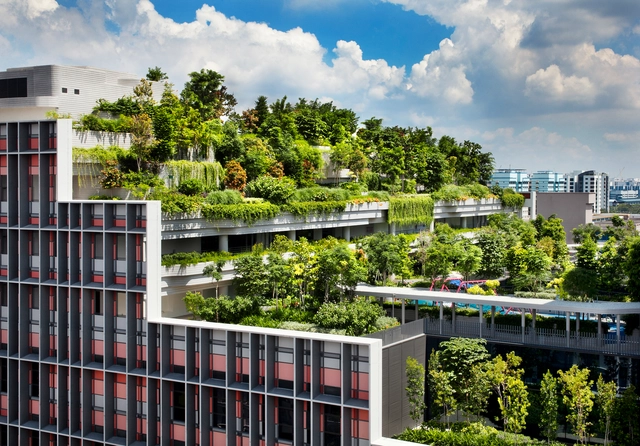
A step-by-step outline on how to turn 3D models in SketchUp into 2D documentation through LayOut.


A step-by-step outline on how to turn 3D models in SketchUp into 2D documentation through LayOut.

The banker Orozimbo Roxo Loureiro created the 500 Club in the early 1950s. It followed the lines of the former 200 Club, founded by President Washington Luís to bring together influential politicians and businessmen away from the spotlight of capital cities. The initial idea of a social club did not prosper, and Orozimbo decided to develop a commercial and tourist enterprise in the area, which is well positioned between the two largest Brazilian cities.

Sustainability needs to go further beyond inspiring speeches and promises, with visible, concrete actions. In order to see this change, it is essential for individuals, companies and governments to take responsibility and act in a sustainable manner in their daily lives and practices. By taking into account the environmental and social impacts of their decisions and seeking more conscious and responsible alternatives, they can take steps to ensure a sustainable future for the next generations. In the construction industry this is even more urgent. Responsible for a large amount of solid waste and greenhouse gas emissions, it is essential for this industry to adopt sustainable practices, such as recycling, to minimize environmental impacts.
However, even though product recycling processes have significantly advanced in recent years, there are still certain challenges associated with the use of recycled materials. This is due to a variety of factors, such as performance and durability, or even due to the difficulty of obtaining suitable raw materials. But there are also successful examples that show the possibilities of recycled materials.

A heavily cited fact within the architecture industry is that the built environment accounts for 40% of global carbon emissions. The concerning statistic puts immense responsibility on construction professionals. The idea of sustainability in architecture urgently emerged as a way of bandaging environmental damage. A wide range of sustainability practices aims no higher than making buildings “less bad”, serving as inadequate measures for current and future architecture. The problem with sustainable architecture is that it stops with ‘sustaining’.
In order to maintain the current state of the environment, the architecture community has been working towards greener means of production. Conventionally, a green building employs active or passive features as a tool for reduction and conservation. Most sustainable designs view buildings as a vessel of their own rather than integrated parts of their ecosystem. With the planet’s current needs, this approach is not enough. It is not enough to sustain the natural environment, but also restore its processes.

Taking care of a plant is not always easy. There are species that must be watered daily, while others can go for a longer period without any contact with water. By looking for the latter, it is possible to design landscaping that considerably reduces maintenance - including the amount of pruning and watering, for example - and water consumption, making it easier for greenery to exist without major headaches: a dry garden.

Over the last few years, bike share systems experienced a renaissance as the pandemic forced a hard decline in other forms of public transportation like trains and commercial flights where people wanted to avoid close contact with strangers. While ridership is now on a slow decline, since much of the “normal life” aspects have returned, many people continue to see bike shares as a viable means of transportation, lured by the ease and affordability of getting from place to place.

This week's curated selection of Best Unbuilt Architecture highlights visionary homes by the ArchDaily community. From a prefabricated house to supporting Ukraine war victims, a modular multi-story house highlighted during the Dutch Design Week, and a villa "shaped" by the Dubai coastline wind flow, this round-up of unbuilt projects showcases how architects move forward from the conventional residence concept to project alternative habitational standards in responding to harsh environments, nature, and technology.
Featuring firms like architecten van Mourik, Archigardener, DKTV, Exint, Kalbod Design Studio, Lana Alk habbaz studio, Mitchell Designs Architecture, Mossawi Studios LLC, Void, and Team Group, the following list explores homes at different scales and varying stages of their development. Whether competition-winning projects or ongoing planned execution, each project develop a vision of living generated by unique site conditions and technical possibilities.

The world of architecture is mourning the death of the renowned Uruguayan-American architect, Rafael Viñoly, who passed away at the age of 78. With more than half a century of experience in the profession, Viñoly was known for his bold and imposing designs that were built in various cities around the world.

The roof is one of the most essential structural elements of nearly every construction. It is the element that allows a delineated space to transform into one that feels protected. Strongly related to the climatic conditions of the context, the roof's variations in aesthetic and structural design have allowed architects to indulge their stylistic preoccupations to convert roofs not only into elements of closure and climate protection but into a character-giving feature that lends identity and flair – especially when the roof becomes a wall.
Following this opportunity, we want to highlight great examples of roofs that also become walls: 13 houses in which the roof completes the façade, delineating not only the interior in its vertical sense but also in the horizontal one.

In the 1956 competition to design the city of Brasilia, Lucio Costa's proposal differed significantly from his competitors'. In contrast with the detailed plans and well-designed perspectives of the other competitors, the winning proposal presented the minimum required by the tender: a drawing of the pilot plan and a report. In the report, a few simple drawings supported the text, demonstrating the architect's ability to synthesize ideas in a few lines.
Having the ability to express an idea through drawing facilitates the design process for an architect or designer, whether it is to develop the concepts, or even to represent the building. A good sketch should be easy to understand, even for those without technical knowledge, and provides a visual representation of the important elements of a project, such as spaces, dimensions, circulation and relationships between elements. Although most architects now master three-dimensional tools and hand sketches are no longer indispensable, there are tools that combine several new functionalities with the good old act of drawing.

Nieuwe Instituut has appointed Jan Jongert / Superuse Studios from Rotterdam as curator of the Dutch Pavilion at the 18th International Architecture Exhibition – La Biennale di Venezia. In response to Lesley Lokko’s overarching theme for this edition of the Biennale, “Laboratory of the Future,” the Dutch curatorial team aims to explore the complex systems that underpin the structures of our societies. The exhibition will be open from 20 May to 26 November 2023.

Mario Cucinella Architects has started constructing two multifunctional towers to shape Vienna’s skyline. Situated in the 2nd district in Vienna, where a dynamic urban development “Viertel Zwei”, has been in the works for some time, the project consists of two highrises, both of different architectural languages and made for different purposes, together providing a complex urban image inserted into context.

There are several constructive technologies to configure the structural system of a building. From the 1960s onwards, the adoption of techniques that enabled the interaction between different materials became increasingly common, diversifying the design language and seeking the main advantages each element has to face certain situations. Over the years, some mix concrete, wood, stones or steel.

This article was originally published on Common Edge.
In 2018, the Roman neighborhood of San Lorenzo hit the headlines when a young girl was found dead in a derelict building. The media focused on the area’s decline, ignoring its long political and cultural history. Known as a “red” territory, San Lorenzo was one of the few districts to resist Mussolini’s 1922 March on Rome. Built in the late 19th century to house a working-class population of artisans as well as rail and factory workers, there’s a gritty feel to the neighborhood, defined by remnants of its industrial past and buildings that still bear the scars of Allied bombing in World War II. This small, centrally located neighborhood is wedged between Termini, the main train station, Verano, the monumental cemetery opened in 1812, and the Città Universitaria La Sapienza (La Sapienza University).

Switzerland’s project for its national pavilion at the 18th International Architecture Exhibition–La Biennale di Venezia will be curated by Karin Sander and Philip Ursprung to explore territorial relationships within the Giardini of La Biennale. Titled “Neighbours,” their project is focused on the spatial and structural proximity between the Swiss Pavilion and its Venezuelan neighbor. By turning architecture itself into the exhibit, the project also highlights the bond between the architects of the two structures: the Swiss Bruno Giacometti (1907 - 2012) and the Italian Carlo Scarpa (1906 - 1978). The exhibition will be on display from May 20 to November 26, 2023.

The hosts and producers of the Uncertain Things podcast, Adaam James Levin-Areddy, and Vanessa M. Quirk, conduct interviews with experts with a variety of experiences to answer the question, “Now what? How did we get here and what is next?”. In this episode with Michael Kimmelman, they touch upon many interesting subjects, namely, The New York Times institution and its evolution, Kimmelman’s new book the Intimate City, and our overall understanding of communities in cities.

Artificial lighting offers a range of strategies for interior design. Widely used in commercial projects and restaurants as an aesthetic device to attract customers and to create environments that stimulate the senses, it can transform rooms and create cozy and well-lit places in residential projects.

Starting from the first sketches of a project, it is essential that the project's design restrictions are well defined. This will guide the project, making it more suitable for its location, owners, and local conditions. Among common restrictions, keeping the project cost low is perhaps the most ubiquitous. We spoke with the VAGA team, an office based in São Paulo, about the challenges and possibilities that working with a tight budget imposes:

US-based architecture firm Populous has unveiled the design of a new multipurpose stadium in Indianapolis, US, planned to serve as the new home for the Indy Eleven professional soccer team. The 20,000-seat arena is situated in the center of the Eleven Park neighborhood development, set to transform the city’s southwest quadrant by introducing office spaces, residential units, retail spaces, parking garages, and amenities such as restaurants, a hotel, and green spaces.

The 18th annual Architecture Exhibition La Biennale Di Venezia is taking place from May to November under the theme of “The Laboratory of the Future”. This year, the Taiwanese Pavilion, organized by the Taiwan Museum of Fine Arts, announced that it will explore the intelligence embedded in surrounding landscapes. “Diachronic Apparatuses of Taiwan” displays how locals throughout Taiwanese history have used their intuition to shape their environment. Furthermore, the project also opens a dialogue about artificial and natural terrain to rediscover what we may learn from nature.

Form and function. Terms that accompany several definitions that belong to architecture, but more is needed to summarize the practice in 2023. Nowadays, building involves understanding the cycles of materials and how each action can be linked to the extraction of natural resources and their damage to the environment. We live in an urgent need to review the way we produce built space. In this search for models that move away from linear systems and provide a constant process of transformation and redistribution of matter, strategies arising from the circular economy emerge as a possible path. Its application in architectural heritage – for maintenance or restoration – can incentive the necessary changes toward a more sustainable society.